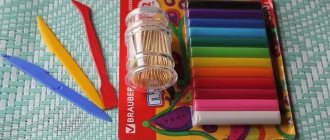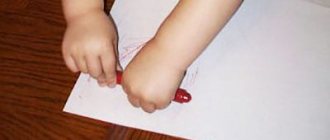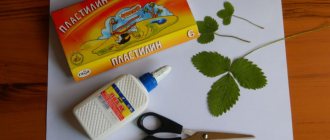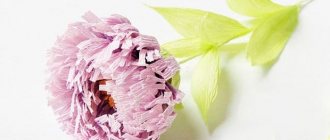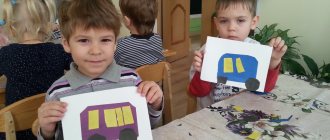Preparation for the application “Boats float on the river”
The success of an application lesson largely depends on its preparation. And here the leading role, of course, belongs to the teacher. After all, in the middle group, the guys still cannot prepare parts on their own.
Suitable materials
First of all, to create a composition you will need a base - a sheet of white A5 paper. The teacher also prepares colored paper for each child:
- long narrow stripes of blue, dark blue or gray (to create the image of a river) or ovals of the same colors (lake);
- paper rectangles of different colors (base for boats) of different sizes (approximate size 7X3 cm);
- scraps of colored paper for decorating boats (flags, portholes, etc.).
You can play with the base in a more interesting way - use blue or light blue cardboard, and give the traditional rectangle wavy edges. This will give the impression that the boat is actually rocking on the waves.
You can play with the base in an interesting way - give a traditional rectangle wavy edges
Of course, to work, preschoolers need scissors, glue, brushes, oilcloths and napkins.
Tips for working on applications with preschoolers
Depending on their age, when making crafts, preschoolers, to one degree or another, need the help of adults. Here are some recommendations for organizing activities with children of different ages:
- For younger preschoolers, you need to prepare generalized applications with a minimum number of small details.
- At 4 years old, children cannot yet independently cut along the contour. Therefore, the necessary materials should be prepared in advance.
- Learning how to apply applique begins with the ability to apply glue with a brush. It is not yet possible for kids to arrange the figures evenly, so it is recommended to first lay out the figures on a sheet of paper and then glue them one by one.
- It is important to encourage children's interest in crafts. The incentive could be to create a gift for dad or mom.
- For older preschoolers, the pedagogical goal of making appliques is the ability to independently cut out parts, select colors and create compositions.
Bright children's crafts serve not only for creating gifts and decorations. They are also an important stage in raising a baby. Crafts with a marine theme are popular in preschool creativity. They vary in difficulty, depending on the age of the children.
Techniques and techniques used
Students in the middle group begin to work with scissors - they learn to cut parts in a straight line, as well as round corners. To create the look of a boat, you need to cut the corners on one side so that the rectangle turns into a trapezoid.
The preschooler's task is to cut off the corners of a rectangle so that it turns into a trapezoid
If the boat is supposed to have a sail, it can be designed in the form of a triangle or semicircle. In the first case, the child cuts a square diagonally, in the second option, the resulting part needs to round the corner, turning it into a semicircle.
To create a sail, the child will need to cut a triangle from a square, and then transform this figure into a semicircle
A semi-oval can also be obtained by cutting off the corners of a rectangle.
You can make a sail from a rectangle, turning it into a semi-oval
First, the teacher clarifies the shape of each part and demonstrates a sample. Children move their hand along the imaginary outline of an object in the air.
The finished boat can be decorated with a flag (triangle).
The finished compositions in the traditional version look something like this
When all the details are cut out, the teacher pays attention to the composition, discusses with the children how to beautifully arrange the boat on the base, depending on their number - one, two or three. After this, the skills of careful gluing are practiced: you need to apply the glue with a brush carefully, in a small amount, with the part being positioned with the colored side down.
Video: boat made of geometric shapes (process of application)
Unconventional applique
You can depict boats floating on the river not only using traditional techniques. Preschoolers can successfully use cut-out appliqué by creating an image from small pieces of randomly sized paper that are torn off by hand.
You can depict a boat using the broken applicative technique
Alternatively, this method can only depict a river or lake.
In the breaking technique you can only depict water
An interesting idea is to make a boat using the origami technique. You need to take the simplest option, when the image is obtained by folding a square and bending its edge. And the work will be complemented by waves from a satin ribbon (the child can easily glue it on, following the teacher’s instructions).
A sailboat can be made very easily using the origami technique, and waves made from satin ribbon will make the composition even more original
Unusual waves can be created from pieces of crumpled napkins. To do this, it is torn into small pieces, and lumps stick together. Another option is to crumple the napkin with your hands to form a flagellum, and then unfold it a little and glue it.
Interesting waves can be made from a crumpled napkin
A similar method is good for depicting clouds in the sky (cotton wool is also suitable for this).
Video: a boat with voluminous sails, sea foam made of cotton wool (the parts are prepared by an adult, and the child glues them on)
What can be added to the application?
Additional visual techniques will help you create an original composition of boats. So, the waves that rock the boat can be painted with watercolors or brighter gouache.
Waves can be painted with watercolors or gouache
Plasticineography also goes well with applique. Thus, plasticine can be used to represent the mast and portholes of a boat, as well as sea waves and a bright yellow sun in the sky.
Applique and plasticineography complement each other perfectly
Ship. Abstract of GCD on application with drawing elements for the middle group
Abstract of GCD on application with drawing elements for the middle group “Boat”
Author
: Efremova Victoria Sergeevna, teacher of MBDOU No. 98, Miass
Program content:
Teach children to create a figurative picture, using previously acquired skills: cut out rectangular objects along the lines - markings, as well as cut off the corners of rectangles, connect parts according to the model and demonstration of the teacher. Develop hand motor skills, imagination, sense of composition, arouse interest in creating an image. Cultivate interest in visual arts and accuracy when performing work.
Handout:
- watercolor paper; - blue watercolor paint; - brush; - white, blue and yellow colored paper; - scissors; -PVA glue, glue brushes, napkins; - felt-tip pens of different colors. (You can simplify the fake, make the applique in several stages, or take a sheet of blue cardboard instead of a sheet of watercolor paper)
Progress of the lesson:
Educator: - Guys, today I want to invite you to go on a trip by sea. Do you agree? (children's answers). What do we need for this journey? (children's answers). I want to read you a riddle, and you try to guess it. What kind of miracles are these: Is the wind blowing into the sails? Neither a ferry nor an airship - It floats on the waves... (Ship) Educator: Well done guys! You guessed the riddle correctly. For our journey we need a beautiful and durable ship. We will start building it now. Your tables have everything you need for this. Well, in order for the ship to turn out strong and beautiful, your task is to listen to me carefully, not to rush, and of course to do the work carefully.
- The first thing we need to do is take a sheet of watercolor paper and
paint half of them with blue paint (let dry a little)
- While the watercolor paint dries, we prepare everything necessary for the application. When the paint has dried, glue half a sheet of blue paper to the background.
- Cut a strip of yellow paper about 4-5 cm wide. Glue it at the bottom of the sheet.
- Take a square of white paper approximately 10*10 cm (prepared in advance). Cut it into two triangles. For one triangle, cut off a corner. (An angle that is 90 degrees)
- Glue a triangle with a cut corner onto a blue background - this will be the boat itself, then a triangle that remains intact - this will be the sail.
- From yellow paper we cut out (according to the markings) a circle - the sun and glue it above the boat. Using a felt-tip pen, draw a mast and decorate the sail.
Educator: - Our boats are ready! We did a great job and now we can go on a trip.
The teacher reads a poem. Today I came to the river, Ship
in my hand.
Let him sail to Wonderland, say hello to his friends, He will see many countries, He will go far overseas, To meet icebergs and the sun, But he will definitely return! M. Piudunen
Individualization of tasks
In fine arts classes, it is imperative to use an individual approach. So, for children who are not yet very good at handling scissors, you can offer to make only boats (hulls), and for those who are already good at cutting out parts - boats with a sail.
During the applique class, the teacher should actively encourage the manifestation of children's activity and creativity. Some children cope with any work quickly, so they definitely need to complicate the task even more - offer to supplement the composition with details: for example, cut out the sun and clouds from paper or decorate their boat with details. You can also give paints so that the child can depict rain or fish looking out of the water.
There are many options here. The main thing is to captivate the child so that his interest in creativity only becomes stronger.
Some children quickly and efficiently cope with basic work; they definitely need to be given additional tasks in order to maintain interest in creativity
Composition options based on theme
According to the visual arts program for the middle group, an application on the theme “Boats float on the river” is offered to preschoolers in October. The composition options are designated as “Fishing boats went to sea” and “Yachts on the lake”.
However, this lesson can be carried out in the spring, connecting the theme with spring streams, along which it is so fun to float paper boats (“A paper boat floats along a stream”).
You can make such an applique for Defender of the Fatherland Day - let it be a warship sailing on the waves, which the children will present as a gift to dad.
The lesson can also be associated with reading V. Suteev’s fairy tale “The Boat”, designating the topic as “A Boat for Animals”. This will be a more fabulous option, and instead of a sail, the teacher can offer each child a fresh or dried leaf of a tree.
The application can be timed to coincide with the reading of the fairy tale “The Ship” by V. Suteev and create the same image
Video: cartoon “Boat” (1956)
Motivating start to class
In order for a child to do work with joy, he must be motivated. This can be done in different ways, for example, using a game character who comes to the children for class and asks for help.
This could be Leopold the cat. The hero reports that he was invited to visit the little mice, but they live far away. To reach them, you need to cross a wide river. And for this you need a boat. Of course, the kids will enthusiastically get to work to help the cat.
Some famous character, for example, Leopold the cat, comes to the guys and asks for help - they need to make him a boat
Another option is a telegram from Doctor Aibolit. Sick animals are waiting for him in Africa. But to go there, you need a ship with sails (after all, it’s a long way to sail).
You can start the lesson with a riddle to intrigue the children. For example, this option:
- A cap is floating along the river From a huge soldier The guys are waving their oars It’s not a cap, it’s... (a boat)
What follows is a discussion of what geometric shape the boat most resembles (a rectangle because it is long). As a result, the teacher invites the children to make their own boats.
Another way is for the teacher to invite the kids to use their imagination and draw a picture based on the poem. The poem “Ship” sounds:
- The boat sailed on the waves, the sail was rushing towards the clouds. The waves rose towards the side and crashed against the ship. Svetlana Sirena (Kotlyar)
Then a conversation is held on the poem, after which the children begin the creative process - creating an image of a paper boat.
You can start a conversation about spring, about how fun it is to launch boats along streams when the sun warms everything around with its warm rays.
To maintain the interest of preschoolers in the topic of application, the teacher must conduct appropriate finger gymnastics or physical education.
Table: finger gymnastics “The wind walks across the sea...”
| Text | Movements |
| The wind blows across the sea | children shake their palms, imitating waves |
| And the boat speeds up | palms cupped |
| He runs in the waves | move fingers starting with thumb |
| With full sails. | fingers spread wide |
Table: physical education (based on a poem by A. Barto)
| Text | Movements |
| Tarpaulin, | put a hat on your head |
| Rope in hand | Place clenched fists next to each other, spread your arms - show the length of the “rope” |
| I'm pulling the boat | cup your palms |
| Along a fast river. | rock the boat |
| And the frogs jump at my heels, | jumping in place |
| And they ask me: | press your hands to your chest |
| - Take it for a ride, captain! | extend open palms forward |
Photo gallery of finished works - ideas for teachers
The application is combined with gouache painting and plasticineography
The applique is combined with drawing with wax crayons. A combination of applique (boats made using origami) and drawing (the sky and reeds)
Original waves are made from strips using the breaking technique
Simple origami, which is complemented by drawing
Application in the form of a postcard for dad with original waves (the teacher prepares them)
A broken applique with filling in a drawn template. Children fill in the drawn outline with pieces of paper; sails made from bright fragments look colorful
Applique classes should practice and improve the visual skills of preschoolers, as well as expand their horizons and knowledge about the shape of surrounding objects. Thus, the theme of a boat or a boat sailing along a river can be played out in a very interesting way, using the right motivation and using unusual materials.
Types of boats with instructions on what can be made
Crafts on the theme “Boat applique” include a lot of variations. You can make a ship with a sail, without a sail, a boat, a boat, a sailing yacht, a submarine.
Application for children “Sailboat”
This craft is suitable as a greeting card for February 23 or a birthday. If the application is performed with small children, adult assistance will be required. Toddlers do not yet have sufficient manual dexterity and subtlety of movements. They don’t know how to cut, they have difficulty gluing parts evenly.
To work you will need to do the following:
- Print the boat template for the applique and cut out the parts from colored paper.
- Draw clouds and waves on the base sheet with a blue pencil. Paint the sky with watercolors. Let the picture dry.
- Start gluing the blanks. First, make voluminous waves from blue stripes.
- Assemble the base of the boat. Using a brown felt-tip pen, draw stripes on the deck that imitate boards. Glue the portholes.
- Using glue, attach the ship parts to the base.
- Lastly, make a white sail fluttering in the wind. To do this, first glue its wide part to the mast, and then, making a slight bend, glue the end of the sail.
Volumetric applique submarine
At home with children, you can have a fun time and make a semi-voluminous applique in the shape of a submarine. To do this you will need:
- cardboard for the base;
- colored pencils or markers;
- colored paper;
- scissors;
- double-sided tape, glue.
- cardboard toilet paper tube – 2 pcs.
The sleeve can be replaced with a cardboard rectangle. It is enough to give it a curved round shape.
Work progress:
- Color the white sheet with pencils. Cut out the clouds in random order. Most of the painted sheet will serve as the water column where the submarine will be located. Glue the parts onto cardboard.
- Cut the sleeve crosswise. Bend the longitudinal edges inward to a width of 2 cm.
- From 2 bushings, cut out a screw, a hatch, a pipe, and portholes.
- Paint the boat as shown in the photo or as you wish. Assemble the structure.
- Attach the submarine to the cardboard using glue or double-sided tape.
Applique boat on a stand
This homemade sea decoration can be a nice gift. It looks quite presentable, and thanks to the stand it can be placed on a table or shelf.
To make a boat applique you will need:
- colored paper;
- blue cardboard;
- pencil, scissors;
- double-sided tape, glue stick;
- wooden stick for the mast;
- decor (rhinestones, bird figures).
For the base of the craft, you can use any boat template for cutting.
Assembly order:
- Cut out the deck and glue portholes onto it.
- Place double-sided tape on the end of a wooden stick. Remove the protective film and glue the mast in the center on the back side of the boat.
- Make a flag from yellow paper. You need to cut a double piece with a fold in the middle. Stick the flag onto the stem.
- Glue the thread with double-sided tape.
- Cut out double colored triangular flags. Glue them on a thread.
- Make a stand. To do this, fold a sheet of A4 cardboard in half. Fold one half in half. Bend the second part 4 cm more. Bend the resulting bottom wide strip again in the opposite direction so that its fold line coincides with the fold on the first half of the cardboard.
- Make volumetric waves from blue stripes 1 cm thick. Use small scissors to make a wavy slit on the front side of the stand. The length of the slot should be 1 cm longer than the bottom of the deck.
- Decorate the stand with rhinestones, stars, and bird figures. Install the boat into the slot.
